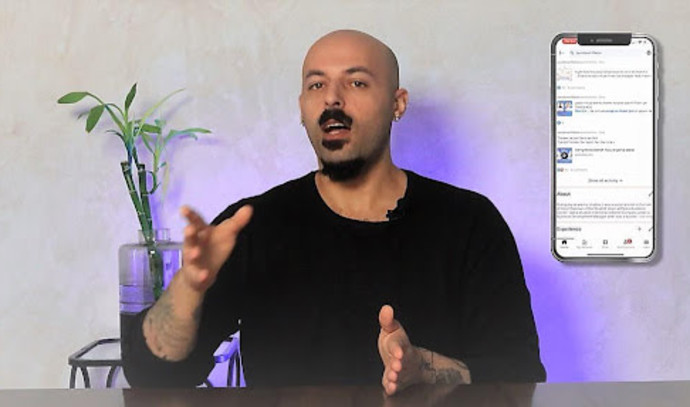LinkedIn in India finally reaches 100 million members. Here’s why it’s more significant than ever:
LinkedIn, the professional networking platform owned by Microsoft, recently announced that it has reached a significant milestone in India. The platform now has 100 million members in India, a 19% increase from the previous year.
India is today the second most populous country in the world after China. When you remove China from the equation because they have their own social networks and are a world unto themselves, it becomes clear that India is the country with the largest population with which one can work.
In order to be considered one of the world’s leading platforms, LinkedIn realized that it had to work in the largest countries in the world, and it seems to be executing this strategy ideally. To understand its impact, we need to understand the challenges.
The Challenges
LinkedIn faces several challenges in expanding its services in India, despite reaching a significant milestone of 100 million members in the country. One of the primary challenges is the need to cater to India’s diverse linguistic and cultural landscape. India has twenty-two official languages, and a minority of the population speaks English. LinkedIn has already taken steps to address this issue by launching a localized Hindi version of its platform in 2019. However, the platform still needs to expand its services in other regional languages to reach a broader audience in India.
Another challenge is the need to adapt to India’s unique job market. India has many small and medium-sized enterprises (SMEs), which account for the majority of the country’s employment. These businesses may have different hiring practices and may not be as familiar with LinkedIn’s services as larger corporations. LinkedIn needs to find ways to reach out to SMEs and provide them with the tools and resources they need to connect with potential employees.
LinkedIn also faces competition from other professional networking platforms that are popular in India, such as Naukri.com and Monster.com. These platforms have a deep understanding of the Indian job market and have tailored their services to meet the needs of local job seekers and employers. LinkedIn needs to differentiate itself from these platforms and provide unique value to its users.
LinkedIn also addressed the issue of affordability. While India has a large and growing population of young professionals, many of them may not be able to afford the subscription fees for LinkedIn’s premium services. LinkedIn needs to find ways to make its platform more affordable and accessible to all users in India, regardless of their financial status.
The affordability challenge in India
LinkedIn has taken several steps to address the issue of affordability in India to make its platform more accessible to users across the country.
One of the key steps taken by LinkedIn is the introduction of a ‘Lite’ version of its mobile app, which is designed to be more data-efficient and accessible in areas with limited internet connectivity. The Lite version of the app is also free, making it more accessible to a wider audience in India.
LinkedIn has also launched a range of free tools and resources for job seekers and employers in India. For example, the platform has partnered with the Indian government to launch a job portal called ‘Skill India’ that connects job seekers with potential employers. LinkedIn has also launched a series of online courses and training programs that are available at no charge to Indian users, helping to upskill the country’s workforce and make them more employable.
Furthermore, LinkedIn has made its premium features more affordable for Indian users. For example, the platform offers discounted rates for students and recent graduates who may be unable to afford the full subscription fees. LinkedIn has also introduced a range of flexible subscription options, allowing users to choose which features they want to access, and pay only for those features.
Finally, LinkedIn has been working to expand its partnerships in India, collaborating with local businesses, educational institutions and government agencies to provide more opportunities and resources for Indian users. These partnerships help to increase the visibility of LinkedIn in India and make it more accessible to a broader audience.
The Partnerships LinkedIn Established in India
LinkedIn has established several partnerships in India to support its growth and increase its visibility in the country. Here are some notable examples:
1. Partnership with Nasscom: In 2017, LinkedIn partnered with the National Association of Software and Services Companies (Nasscom) to launch a new initiative called FutureSkills. The program aims to provide upskilling opportunities for Indian professionals in emerging technologies such as artificial intelligence, blockchain, and cybersecurity. LinkedIn provides its platform and resources to support the initiative, helping to connect learners with relevant courses and job opportunities.
2. Partnership with the Government of India: LinkedIn has partnered with the government of India on several initiatives, including the Skill India program mentioned earlier. In 2020, the platform also launched a new service called ‘Open for Business in India,’ which helps small businesses to create an online presence and connect with potential customers. The service was launched in collaboration with the Ministry of Micro, Small, and Medium Enterprises (MSME).
3. Partnership with educational institutions: LinkedIn has established partnerships with several educational institutions in India, including the Indian School of Business (ISB) and the Indian Institute of Technology (IIT) Delhi. These partnerships provide students with access to LinkedIn’s resources and tools, helping them to build their professional networks and locate job opportunities.
4. Partnership with media companies: LinkedIn has partnered with several media companies in India to provide users with access to relevant news and insights. For example, the platform has partnered with the Economic Times and CNBC TV18 to provide users with business news and analysis. These partnerships help to increase the value of LinkedIn for Indian users and provide additional resources for them to learn and grow in their careers.
Overall, LinkedIn’s partnerships in India demonstrate the platform’s commitment to supporting the country’s workforce and providing value to its users. These partnerships help to increase the visibility of LinkedIn in India and provide opportunities for the platform to grow and expand its services in the country.
How will this affect users in Israel?
It is difficult to say with certainty that there will be an immediate impact. Many people In the world of business and entrepreneurship in Israel have been working with Indians for the past 20 years, and the fact that LinkedIn is growing stronger in India means that the relationship between Israelis and Indians will even become stronger and will be more accessible, for better or for worse.



